Item
Secretary Albright’s Commission
Duplicate of the original appointment commission for Secretary of State Madeleine Albright, dated January 23, 1997 and signed by President Bill Clinton and Acting Secretary of State Peter Tarnoff.

Secretary Madeleine Albright was a trailblazer as the first woman Secretary of State. One of her most significant accomplishments was helping to expand NATO to include more countries in the 1990s.
Why was expanding NATO so important to global security? And what role did Secretary Albright play in achieving this diplomatic milestone?
Madeleine Albright’s personal history gave her unique insights into the realities of the Cold War. The daughter of Czechoslovak diplomat Josef Korbel, her family had first fled from Prague to London during World War II to escape the Nazi invasion.
After the War, as a diplomat assigned to Yugoslavia, Korbel soon realized that the post-War Czechoslovak government was not truly independent but, in reality, under Soviet control. The family once again fled in 1948, this time to the United States. These events early in her life gave Albright first-hand experience as a refugee from communism. Equally, she understood the divisions caused by the Cold War and the hardships endured by Eastern European countries unwillingly caught in the Soviet sphere.
Before being named Secretary of State, Albright had extensive experience in international and U.S. government affairs. She worked as a legislative aide to Senator Edmund Muskie and later as international affairs adviser to his presidential campaign. This experience and positions on the National Security Council and as a professor at Georgetown University led President Clinton to appoint her as U.S. Ambassador to the United Nations.
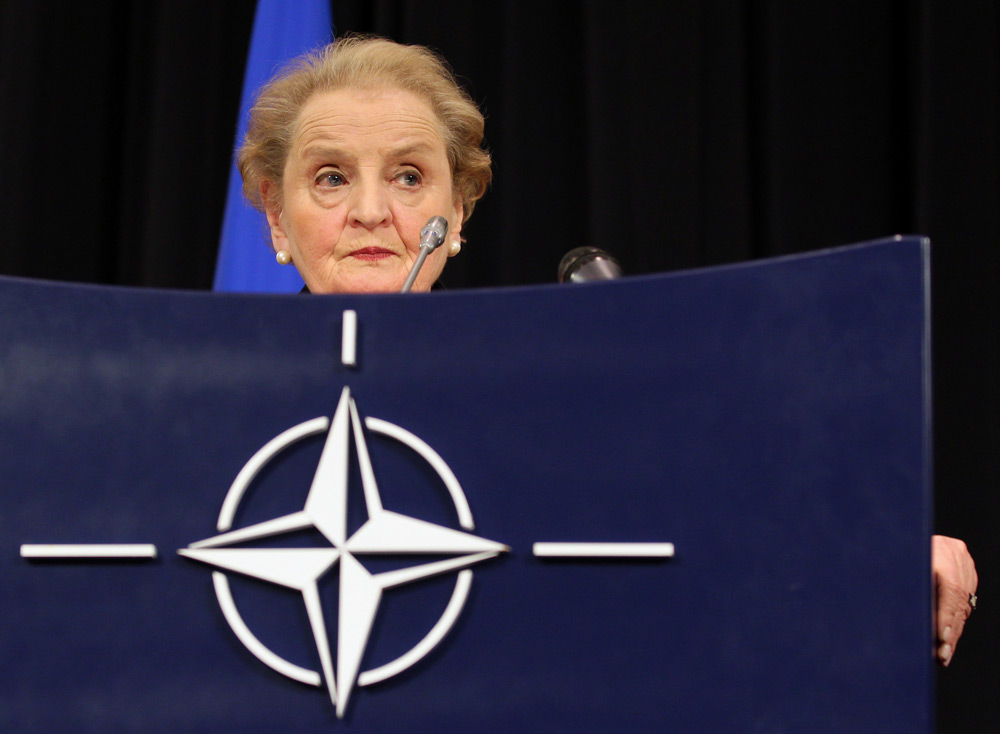
The North Atlantic Treaty Organization (NATO) is a military alliance. It was created by the United States, Canada, and several Western European countries in 1949. Initially, the primary goals were to deter Soviet expansionism, discourage nationalist militarism, and integrate Europe politically. While it started with 12 countries, NATO now includes 30 countries from North America and Europe.
Article V of the treaty reads, “an attack against one Ally is an attack against all.” This mutual defense guarantee is a cornerstone of the alliance. NATO members also consult with one another on a range of security issues that can affect everyone, such as terrorism, cybersecurity, and piracy. NATO also leads peacekeeping missions and training exercises around the world.
Just a couple of years after World War II, threats of conflict were already appearing in places like Greece, Turkey, Czechoslovakia, and Italy. Also, relations with the Soviet Union were growing tense. The Soviet Union, which controlled East Berlin, blocked East Berliners’ ability to travel to the West. This cut off their access to food, fuel, and basic goods.
In response to the threat against democracy in Greece and Turkey in 1947, President Harry S Truman proposed using financial aid for military and economic assistance. This aid was a diplomatic tool to combat communism’s influence. Known as the Truman Doctrine, this diplomatic act of sending aid to countries instead of direct military intervention continued throughout the Cold War.
Western European nations also sought to rebuild their economies and security infrastructure after WWII. The United States responded using diplomatic tools, including aid through the Marshall Plan. Although the Soviet Union had been a U.S. ally during WWI, it did not want to participate in this plan and prevented Soviet-controlled Eastern European countries from receiving benefits. This concerned the United States and other neighboring countries.
Economic aid alone, however, does not always provide national security. Great Britain, France, Belgium, the Netherlands, and Luxembourg wanted to safeguard their democracies against encroaching threats. President Truman and the U.S. Congress agreed with these efforts, seeing a strong, prosperous, and democratic Europe as in the U.S. interest. After much debate about the treaty’s wording, NATO was created in 1949. This was the first time the United States had ever entered into a peacetime military alliance with a non-Western Hemisphere country.
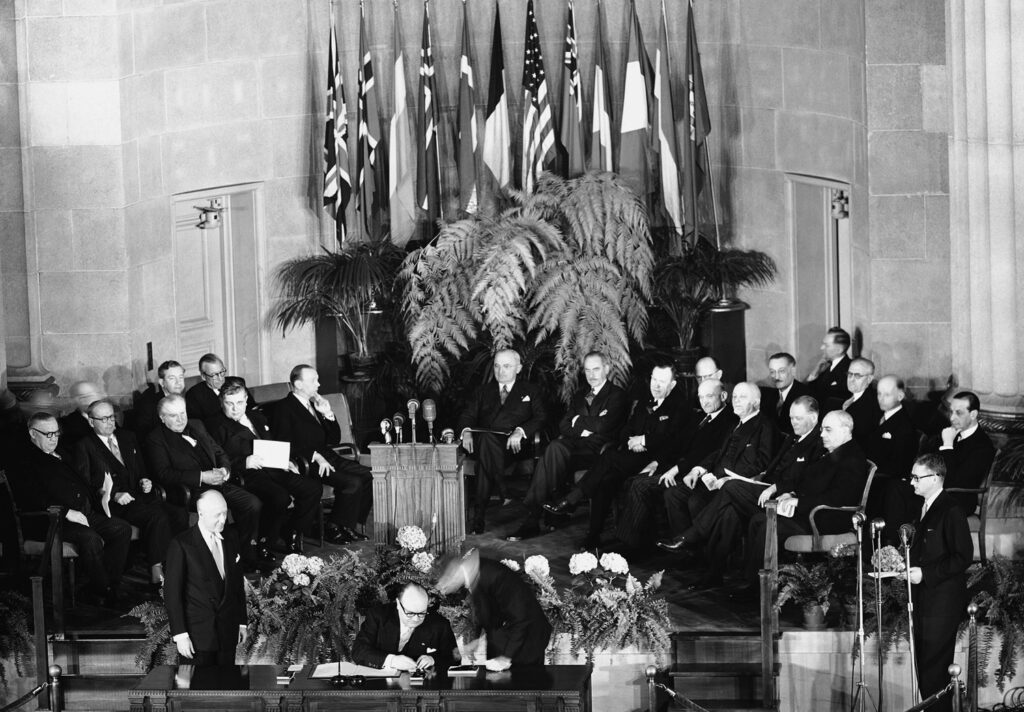
Ultimately, Belgium, Canada, Denmark, France, Iceland, Italy, Luxembourg, the Netherlands, Norway, Portugal, the United Kingdom, and the United States formed NATO in 1949. The combination of economic aid and military security gradually led to greater political stability among NATO members, and Greece and Turkey joined the alliance in 1952.
When NATO decided to admit West Germany in 1955, the Soviet Union responded by creating the Warsaw Pact, a military alliance consisting of the Soviet Union, Albania, Bulgaria, Czechoslovakia, East Germany, Hungary, Poland, and Romania (Albania withdrew in 1968).
The Cold War saw an arms race between the Soviet Union and the United States and considerable political tension between the East and West blocs. Throughout the Cold War, NATO played a vital role in maintaining collective defense and protecting its members from potential threats from the Soviet Union.
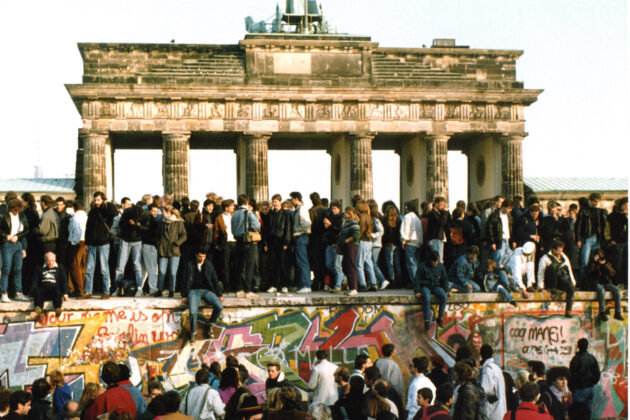
Period
Cold War Diplomacy
As the Soviet bloc began to collapse in 1989, some in the West wondered whether NATO needed to continue. However, the collapse of the Soviet bloc brought significant political uncertainty. NATO Secretary General Manfred Wőrner observed in 1993 that “the collapse of Soviet communism has left us with a paradox: there is less threat, but also less peace.”
The political instability and uncertainty that followed the dissolution of the Soviet Union had profound consequences for NATO’s future. The reunification of Germany on October 3, 1990, led East Germany to withdraw from the Warsaw Pact as it became a NATO member through unification with West Germany. The Warsaw Pact dissolved in 1991, leading its former East European members to seek closer cooperation with NATO to advance their stability, democracy, and integration with Europe. NATO established the North Atlantic Cooperation Council in 1991 to cooperate with its Central and East European and Central Asian neighbors.
The post-Cold War power vacuum that led to nationalism and political instability, particularly in the former Yugoslavia, underscored an important role for NATO in providing a framework for strengthened military cooperation and partnership throughout the region. In 1994, NATO created the Partnership for Peace (P4P), setting up a framework for willing non-NATO countries to share information with NATO allies, modernize their militaries along democratic standards, and conduct joint military exercises as a way to develop operability across the partnership. For countries interested in becoming NATO members, the P4P offered a political and military roadmap that could lead to membership.
As the war and ethnic cleansing in the former Yugoslavia worsened, NATO increased its initial role of supporting the United Nations’ efforts to end war crimes. NATO made direct military action in 1995 that helped to bring the conflict to an end and implement the Dayton Peace Accords.
This political and military uncertainty led NATO’s Central and East European neighbors to push for NATO membership—a concept with which many NATO member governments agreed.
Albright’s professional expertise and personal experience gave her a clear understanding that the collapse of the Soviet Union offered an opportunity to unify Europe. She also realized that bringing the newly independent countries of Eastern Europe into European institutions would benefit both European and U.S. security interests. These nations wouldn’t be in limbo between east and west. It also could prevent countries from seeking alternate security structures that could compete with West European institutions. Through her extensive contacts with East European leaders, she knew well that they aimed to meet the requirements to be invited to join the NATO alliance.
At the Brussels NATO Summit in January 1994, members came together and said they “would welcome NATO expansion that would reach to democratic states to our East.” President Bill Clinton supported this declaration.
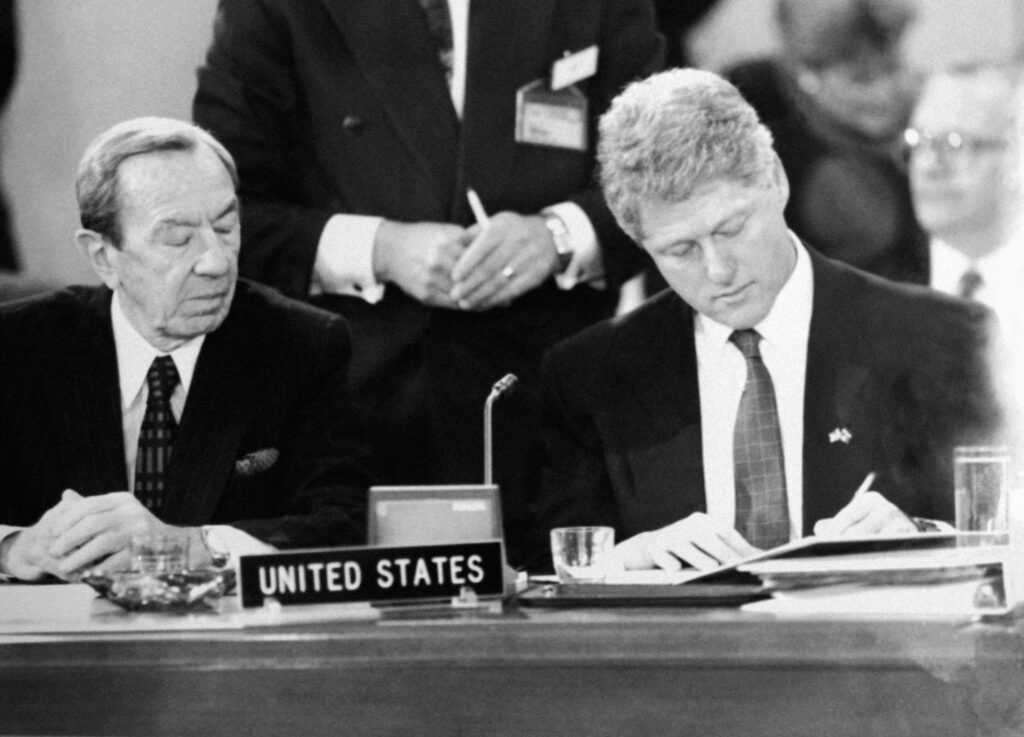
Concerned that her personal connection to the Czech Republic would give the appearance of bias, Albright did not immediately advocate loudly for NATO enlargement. When President Clinton agreed with NATO leaders about the wisdom of enlargement, Albright took on the decision as one of her top priorities as Secretary of State. At that point, she was clear and persuasive in articulating why enlargement served U.S. security interests.
Although there was widespread support for NATO enlargement to admit former members of the Warsaw Pact, many U.S. foreign policy experts were adamantly opposed to expanding NATO. George Kennan, a famous diplomacy scholar, called it “the greatest mistake in Western policy in the entire post-Cold War era.” Ultimately, critics thought expansion would antagonize Russia and put any arms-control treaties at risk of failing.
The American public supported NATO but was largely indifferent about expanding its membership.
Russia opposed the enlargement because, among other reasons, an expansion would move the protective border of a NATO alliance closer to Russia.
NATO’s openness to enlargement, expressed at the Brussels summit, was followed by vigorous debates in NATO capitals, including Washington, DC.
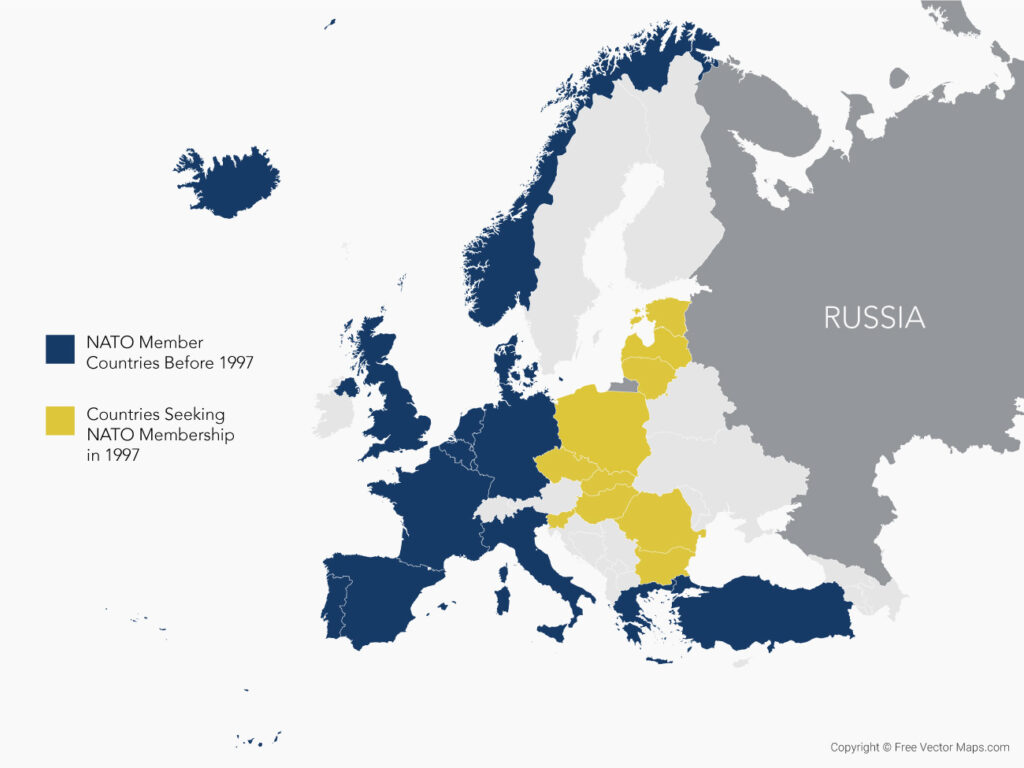
In 1997, Madeleine Albright was sworn in as the 64th U.S. Secretary of State. She was the first woman ever to hold the position.
One of Albright’s main priorities was to support and guide President Clinton’s commitment to a free, prosperous, and strong Europe. It was in the U.S. interest that European democratic nations could make their own choices about alliances and their future. Albright explained U.S. interest in NATO enlargement as follows:
The fundamental goal of our policy…is to build, for the very first time, a peaceful, democratic, and undivided transatlantic community. It is to extend eastward the peace and prosperity that western Europe has enjoyed for the last 50 years. In this way, America will gain strong new partners in security and trade. And we will gain confidence that our armed forces will not again be called upon to fight on European soil.
An important part of this goal was to build cooperation with Russia to make clear that NATO expansion was not a threat to Russia’s security.
One month into the job, Albright went on a 10-country European tour in February 1997. This tour included a trip to Russia to meet with Foreign Minister Evgeniy Primakov and President Boris Yeltsin. Recognizing Russia’s unease over NATO enlargement, President Clinton met with Russian President Boris Yeltsin at a summit in Helsinki to explore areas of cooperation between NATO and Russia. At the same time, they established that Russia did not have a veto over NATO decisions on enlargement. In May 1997, NATO Secretary General Solana and President Yeltsin reached an agreement on the terms of the NATO-Russia Founding Act, which laid out terms of cooperation between NATO and Russia.
During this inaugural tour, Albright traveled to several NATO capitals to express U.S. support for enlargement and measure support among other key members. Many members already supported the expansion. But, there was an active discussion about how many and which countries to invite. Albright advocated for NATO expansion on behalf of the United States at a February 1997 special NATO ministerial meeting, where she emphasized that:
“Peace is not a gift. It must be earned and re-earned. And if it is to last, it must be constantly reinforced.”
– U.S. Secretary of State Madeleine Albright
Equally important, the White House needed the support of the U.S. Senate, as they would ratify any treaty of enlargement. In April, Albright testified before the Senate Armed Services Committee, outlining the Clinton administration’s rationale for supporting NATO enlargement. In October, Albright participated in extensive hearings at the Senate Foreign Relations Committee.
Why would America choose to be allied to Europe’s old democracies forever, but its new democracies never?… Were we to do that, confidence would crumble in Central Europe, leading to a search for security by other means, including costly arms buildups and competition among neighbors.
While building support for NATO enlargement and addressing concerns, together with others in the Clinton administration, Albright helped build consensus on which countries to invite to join NATO.
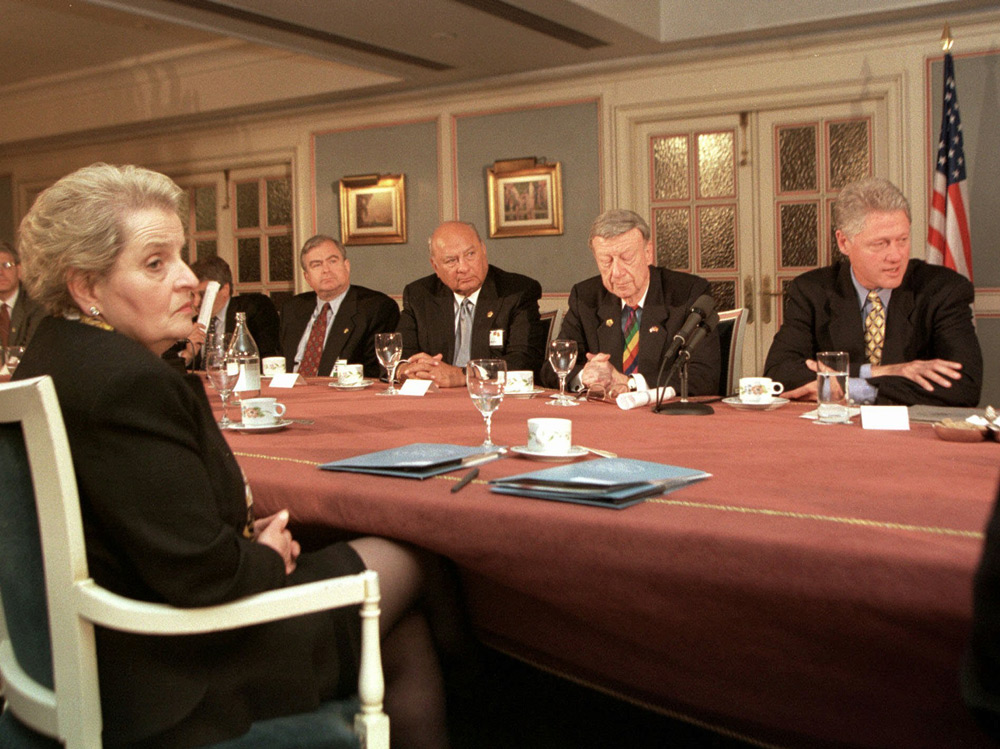
There were competing views among existing NATO members about how many countries to invite and which countries should join. Contenders included Bulgaria, the Czech Republic, Estonia, Hungary, Latvia, Lithuania, Poland, Slovakia, Slovenia, and Romania.
Albright was heavily involved in the negotiations to agree on which countries. She was focused on building consensus on the specifics of enlargement while preventing rifts between member countries. France pushed strongly to include Romania, but the United States favored limiting the first round of enlargement to three countries. The final agreement was to invite Poland, Hungary, and the Czech Republic in the first round and to emphasize to other prospective members that NATO’s door was open to qualified countries in future rounds.
In December 1997, Poland, Hungary, and the Czech Republic signed the NATO Accession Protocols. The U.S. Senate voted in favor of NATO expansion, 80-19, on May 1, 1998. Finally, in March 1999, these countries participated as new members at the NATO Summit in Washington, DC, on NATO’s 50th Anniversary.
Later rounds of expansion have brought NATO membership to 30 countries in total. Bulgaria, Estonia, Latvia, Lithuania, Romania, Slovakia, and Slovenia joined in 2004. Albania and Croatia joined in 2009. Montenegro joined in 2017, and North Macedonia joined in 2020.
NATO does not only work with its own member countries. Some mechanisms allow non-member European countries to still benefit from the alliance.
The Partnership for Peace program, established in 1994, was established to strengthen security within all Central and Eastern European countries. Through this program, countries undertook defense reform and participated in military cooperation exercises, disaster response, emergency planning, and more. Member countries also contributed peacekeepers or troops to NATO-led operations in Bosnia and Herzegovina, Kosovo, and Afghanistan.
Currently, there are 20 members of the Partnership for Peace program working with NATO:
Today, countries continue to seek NATO membership. Finland and Sweden applied to join NATO in the wake of Russia’s invasion of Ukraine in 2022. They were invited to join the NATO summit in Madrid in June 2022. As of January 2023, 28 of the 30 NATO members had ratified the accession protocol.
Ukraine is not currently a member of NATO but has long sought membership. In fact, they have partnered with NATO since the early 1990s. They joined the North Atlantic Cooperation Council in 1991 and the Partnership for Peace Program in 1994. In 1997, the NATO-Ukraine Commission was established through a partnership agreement, further strengthening relations. Ukraine’s 2020 National Security Strategy re-established its aim to become a member of NATO.
NATO has increased its support for Ukraine since the 2014 illegal annexation of Crimea. NATO says it “condemns Russia’s war of aggression against Ukraine in the strongest possible terms.” Further, NATO’s website says, “The Alliance will always maintain its full support for the territorial integrity and sovereignty of Ukraine within its internationally recognized borders.”
NATO directly contributes to the security, prosperity, and liberty of the people of the United States and every ally. The alliance promotes democratic values and encourages consultation and cooperation on defense and security issues. This work builds trust among allies and, in the long run, prevents conflict. NATO is committed to the peaceful resolution of disputes. If diplomatic efforts fail, it has the military capacity to undertake crisis-management operations.
Sources
Declaration of the Heads of State and Government, NATO, January 11, 1994
William J. Clinton, The President’s News Conference in Brussels Online by
Gerhard Peters and John T. Woolley, The American Presidency Project
Public Indifferent about NATO Expansion, Pew Research Center
Albright Speech on the Occasion of the Accession into NATO, March 12, 1999
The U.S. Decision to Enlarge NATO: How, When, Why, and What Next?, Brookings Institution
The Debate on NATO Enlargement, U.S. Senate, October 7, 1997